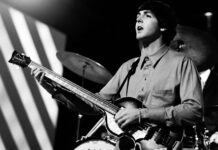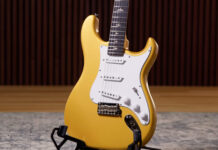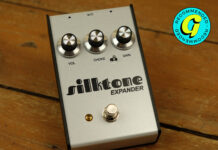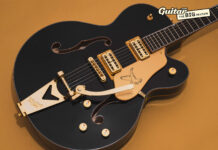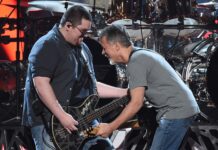
The Genius Of… Keep It Hid by Dan Auerbach
Ch-ch-ch-changes…
It took Akron, Ohio duo The Black Keys over a decade of playing together as a two-piece to countenance any kind of major change. Not surprising, really, given that over the span of four studio albums up to 2006’s Magic Potion – their first album of all-original material – they’d crystallised their raw talent into a winning formula without having to compromise the smears of feedback, the dirt under the fingernails and the literal basement-tape recording ethos that characterised their sound.
By 2008’s Attack & Release, however, their horizons were expanding. Auerbach’s curt, anguished vocals were still underpinned by a relentless production line of feral blues-rock riffs and Carney’s dynamic, expressive drums, but working with an outside producer in Brian Burton (aka Danger Mouse) had admitted instrumental flourishes, keys, bass and outside musicians into the mix – among them was guitarist Marc Ribot, who’d played in Tom Waits’ band with Carney’s saxophonist uncle Ralph. It was also obvious from duet Things Ain’t Like They Used To Be (the album’s sole Auerbach-only songwriting credit) that his writing talent was in bloom, pushing up against the limits of the two-piece format.
New studio = new sound
Following his first taste of recording a Black Keys album in a pro studio with Attack & Release, Auerbach spent the next couple of years creating his own custom recording environment in Akron, collaborating with studio expert, musician and producer Mark Neill and drummer, multi-instrumentalist and co-engineer Bob Cesare to create Akron Analog. During this process, Cesare became a key collaborator on the material that was to become Keep It Hid, playing the majority of the drums on the finished album, while Neill engineered it. All of the finished tracks, save for When The Night Comes, were recorded at Akron Analog.
Auerbach told AV Club this new environment was everything he could ever want in a studio: “The live room is acoustically correct. The sounds are perfectly balanced so you can record by playing live. It has the tape machines I want, the recording console that I want, the microphones that I want. I could stay in there all day, sometimes. I just love the sound and the idea of playing in a room with other people, which is what the majority of the record is.”
Image: Nonesuch RecordsThough he later confirmed that the solo album wasn’t an attempt to divorce himself from the Black Keys sound, there was tension between the pair at the time, with Auerbach neglecting to inform his bandmate that he was even making the album. Confusingly enough, while Auerbach toured it, Carney formed a side project along with four other Ohio-based skinbeaters called Drummer, in which he played bass.
Mustering his family and friends around him in this new environment, playing and harmonising with his guitarist uncle John Quine and even co-writing with his father on Whispered Words (Pretty Lies), Auerbach whittled down a stockpile of songs mostly written on the road into a sprawling 14-track sequence, with one Wayne Carson cover. “I had about 20 songs that I thought were real keepers, and about 35 altogether. I sort of had my mind made up which songs were gonna make the album,” he told Cleveland Scene. “It was all intentional, every little twist and turn on the record. And it’s really split up like side A and side B on an LP.”
Auerbach performs onstage at Terminal 5 on 6 February 2009 in New York City. Image: Roger Kisby / Getty ImagesSoak up the atmosphere
These ‘twists and turns’ were the sound of Auerbach shining the spotlight on the influences and musicality which, if not exactly kept hid, had certainly been constrained by the two-piece setup. Keep It Hid’s rich sonic world is what’s most consistently overlooked. Spacious arrangements highlight Auerbach’s plaintive vocals on the likes of Whispered Words (Pretty Lies) and When The Night Comes in a way that’s rarely been equalled elsewhere in his work.
The album’s stark musical contrasts are effortlessly resolved, to the extent that the homely acoustic ballads that bookend the album (Trouble Weighs A Ton and Goin’ Home) and the deep tremolo and effects-soaked twin guitars of Heartbroken, In Disrepair somehow seem like sides of the same coin. Similarly, the filtered guitar wig-out of Street Walkin’, the anachronistic drum-machine intro of Real Desire and the Creedence-esque My Last Mistake make for odd, yet still compatible bedfellows.
Auerbach’s knack for smuggling in dark lyrical themes under the cover of disarmingly straightforward melodies and innocent-seeming song structures works like a charm on The Prowl, with its shards of menacing guitar and distorted Tom Waits-esque vocals, and the swampy minor-blues of When I Left The Room. The latter’s spectral wails of reversed lead playing link with other strange ambiences, including the 53-second sound collage of Because I Should and the outros of the last two songs, where he manages to make an instrument as innocent as the glockenspiel sound eerie.
Auerbach performs at the 2009 All Points West Music & Arts Festival at Liberty State Park on 2 August 2009 in Jersey City, New Jersey. Image: Theo Wargo / WireImagePerhaps the old ways are best…
Auerbach was only 29 when Keep It Hid was created, but he’d already become a byword for retro nostalgia, thanks to The Black Keys’ intense revisioning of ancient blues forms and (along with Jack White) his appreciation for forgotten, long-obsolete US ‘Sears catalogue’ guitar models. The guitar Auerbach is cradling on the cover is a 1965 Tesico Del Rey ET-300 and the fact that the charms of Teisco, Silvertone, Guild and Harmony were rediscovered at all is mostly down to White and Auerbach popularising them.
“Especially on record since I started, I’ve played more Harmony guitars than anything,” Auerbach told MusicRadar. “I really love some of those late-50s, 60s Harmony guitars… they play really well, they hold up for the most part… they use DeArmonds made in Toledo, Ohio – they’re just really funky, high output, they just sound good, you know.”
Yet Keep It Hid sounds authentically old as the hills and this is aided by the ears of engineer Mark Neill. “He did it completely analogue, no digital effects or anything,” Auerbach recalled. “Any slap-back is a big old tape machine. Any reverb is a giant eight-foot-long metal plate. We stayed pretty true to the idea of recording and mixing in an old-school way.”
The missing link
Listening to Keep It Hid a decade on, the old adage that ‘they don’t make them like they used to’, rings true – and neither, as it turns out, does Auerbach. His next solo album, Waiting For A Song, eight years later, was different altogether – beautifully crafted and more polished, but ultimately less intimate and memorable.
It could be argued that the most pivotal album in The Black Keys’ career – the one that provided the sonic stepping stone between uncompromising two-piece and the triple-Grammy-winning swagger of the following year’s psychedelic falsetto-and-fuzz-drenched commercial breakthrough Brothers album – wasn’t even a Black Keys album. It was Keep It Hid, an intimate, still underrated tour de force.
Auerbach performs on stage at Luna Park on 9 January 2009 in Sydney, Australia. Image: Graham Denholm / Getty ImagesInfobox
Dan Auerbach, Keep It Hid (Nonesuch Records, 2009)
Credits
Bob Cesare (drums, percussion, rhythm guitar, assistant engineer)
Dave Huddleston (upright bass)
James Quine (rhythm guitar, backing vocals, photography)
Jessica Lea Mayfield (backing vocals)
Rob ‘Thorny’ Thorsen (upright bass)
Mark Neill (recording, engineering, mixing, maracas)
Dan Auerbach (all other instrumentation, recording, engineering)
Jim DeMain (mastering)
Amy Burrows (design)
Standout guitar moment
Mean Monsoon
More information about Dan Auerbach here. For more features, click here.
The post The Genius Of… Keep It Hid by Dan Auerbach appeared first on Guitar.com | All Things Guitar.
Source: www.guitar-bass.net

